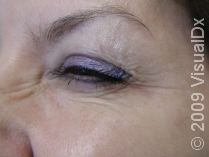Most people are probably familiar with or have heard of Botox, but how much do you know about what it’s used for and how it works? Botox is one of several brands of injectable medicine (such as Dysport, Xeomin, and Jeuveau) that contain the molecule botulinum toxin. Botulinum toxin is a protein that is produced by the bacteria Clostridium botulinum that has some very interesting properties. This protein has the ability to paralyze the respiratory muscles necessary to breathe. However, scientists have found ways to harvest and utilize this toxin in very small concentrations to safely treat a number of medical and cosmetic conditions such as muscle spasticity, excess sweating, wrinkles, migraines, and more. The two conditions that most commonly bring patients to dermatology offices for botulinum toxin injections are wrinkles and excessive sweating.


Dermatologists (and many other healthcare providers) offer botulinum toxin injections to prevent and reduce wrinkles. As we age, our skin becomes thinner and less elastic, creating creases in the skin that we can wrinkles. When the muscles of our face move, they scrunch up the overlying skin and decrease the appearance of wrinkles. In addition to minimizing the appearance of wrinkles that are already there, the paralysis of the muscles can also have a preventative effect by slowing down the process of wrinkles being etched into the skin in the first place. While botulinum toxin paralyzes these muscles, the paralysis doesn’t last forever. Eventually, the body breaks down the botulinum toxin and the muscles are able to move again. This typically takes around 3 to 4 months; however, the length of effect can be shorter or longer depending on the person.
The less frequent use of botulinum toxin in dermatology is for treatment of excess sweating (hyperhidrosis). Hyperhidrosis is a medical condition in which a patient has unusually high sweat production, beyond what is considered normal or appropriate for regulating body temperature. Hyperhidrosis can either be generalized, in which there is diffuse sweating all over the body, or it can be localized, in which is affects only specific locations in the body – most commonly the hands, feet, face, armpits, or groin. In the same way that botulinum toxin blocks the nerves that control the muscles, it can also block the nerves that control the sweat glands. This effect can drastically reduce the excessive sweating from hyperhidrosis and significantly improve the quality of life for patients. Just like botulinum toxin for wrinkles, the injections for hyperhidrosis will eventually wear off. The effects typically last anywhere between 4 and 12 months but will vary based on the location injected and the individual patient.
While these are the two most common uses for treating dermatologic conditions, there are many other uses for Botox in other specialties. Many studies are in the pipeline to test out new indications for the drug, and several other companies have or are bringing their own versions of botulinum toxin, be sure to visit your dermatologist to learn more about potential treatment options available.
by Michael Ryan, University of Texas Medical Branch
